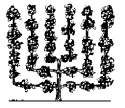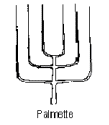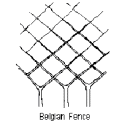|
 |
|
|
|
 |
 |
 An espaliered plant is one that has been trained to grow
in one plane such as flat against a wall or fence or
supported by a trellis. It has only two dimensions,
height and width without depth. In the 17th Century, 'espalier' originally
referred to the frame or trellis on which the plant was
trained. Today, espalier refers to both the
two-dimensional tree or shrub or the horticultural
technique of actually training the plant. An espaliered plant is one that has been trained to grow
in one plane such as flat against a wall or fence or
supported by a trellis. It has only two dimensions,
height and width without depth. In the 17th Century, 'espalier' originally
referred to the frame or trellis on which the plant was
trained. Today, espalier refers to both the
two-dimensional tree or shrub or the horticultural
technique of actually training the plant.
 This
has been a common practice in
Europe for centuries where
people used it to grow fruit in small spaces. George
Washington used them at
Mt Vernon for fruit production. Espaliered
plants are used in today's landscape for both function
and beauty. In an area where space is limited or where a
plant is needed to decorate a large blank wall, the
espalier is most helpful. This
has been a common practice in
Europe for centuries where
people used it to grow fruit in small spaces. George
Washington used them at
Mt Vernon for fruit production. Espaliered
plants are used in today's landscape for both function
and beauty. In an area where space is limited or where a
plant is needed to decorate a large blank wall, the
espalier is most helpful.
 Espaliers
are also used to provide an accent plant and to give a
tracing effect against a wall in the winter season. They
are great for spaces where there available room for a
tall plant but no room for something with a large
diameter. In addition, they may be used to soften the
effect of a brick wall, large fences or other feature. Espaliers
are also used to provide an accent plant and to give a
tracing effect against a wall in the winter season. They
are great for spaces where there available room for a
tall plant but no room for something with a large
diameter. In addition, they may be used to soften the
effect of a brick wall, large fences or other feature.
Study the lines and shapes of the house or other
landscape features to make sure that the espalier fits
properly. Keep it in proportion to its surrounding
landscape features and place it so that maintenance is
not difficult. An untrimmed espalier will tend to
detract from the landscape appearance.
As in the case of weeping trees, espaliers are an
oddity. They are used to show a uniqueness in form in
the landscape. Therefore, they should not be overused or
they will loose this trait and defeat their purpose. One
or two in a garden space are usually enough to do the
job. Of course, if your goal is simply to grow fruit,
the more the merrier.

|
|
 |
 |
 Espalier
displays can come in a wide variety of forms and
structures. Names of these types include candelabra,
chevron, tiered, cordon, basket weave, Belgian weave,
fan, pinnate and palmate shapes among others. The choice
for your landscape depends on how much space you have,
the amount of space available and the amount of effort
you are willing to commit to for maintenance over coming
years. Espalier
displays can come in a wide variety of forms and
structures. Names of these types include candelabra,
chevron, tiered, cordon, basket weave, Belgian weave,
fan, pinnate and palmate shapes among others. The choice
for your landscape depends on how much space you have,
the amount of space available and the amount of effort
you are willing to commit to for maintenance over coming
years.
For most of the more intricate designs, you will need to
put up some temporary guides to help you for the first
few years. These can be made of wires stretched out or
bamboo canes tied into the proper form. In some cases,
the use of manufactured trellis work will do the trick.
Whatever the guide you use, it needs to be held in place
well enough to be able to support the branches as they
are growing. Remember, that to get the basic form of
your espalier in place may take several growing seasons
so the guides must not be unattractive for your
landscape during that time.
|
|
|
 |
|
 |
 |
Originally, espalier was
used to produce fruit in
European gardens but, with the
introduction of dwarf trees, the popularity of espalier
declined. Today, most espaliers are primarily ornamental
with a secondary role of fruit production.
So, in addition to fruit
trees (covered below),
a fairly wide range of woody plants may be successfully
used for espalier. Generally speaking, the plant needs
to be fairly fast growing since you don't want to wait
too long for the results. It also needs to have a lot of
what are called
adventitious buds waiting to break and
grow. This is why most conifer species are not grown as
espaliers. The species has to be adaptable to pruning
and, it needs to be fully hardy for your climate zone.
Other factors to consider would include: |
Age. When starting an
espalier, plants (trees or shrubs) should be young and
supple. They need to have limbs that easily bend without
breaking. Stiffly-grown young trees, unless they meet
the design requirements, may need to be pruned to the
ground and started all over again.
Flexibility. A shrub or
tree that produces long, flexible branches is well
suited for training as an espalier. Avoid
plants with stiff branches.
Height. Consider the mature height of a plant when
selecting one for a particular location. Of course, by
pruning, you can regulate the height of the plant,
but, if you want it to grow 20 feet up the side of
the house, it has to be a plant that will reach that
size. Select a plant whose
mature height closely matches the height of the area
where it is to be espaliered.

|
|
 |
 |
 Apple,
pear and peach trees are probably the most commonly
grown plants for espaliers. They can be dated back
to Roman times when they were used in small
courtyards to produce fruit for the household.
Today, we have many more options available in our
fruit trees and we need to consider some of these in
selecting types for espalier. Apple,
pear and peach trees are probably the most commonly
grown plants for espaliers. They can be dated back
to Roman times when they were used in small
courtyards to produce fruit for the household.
Today, we have many more options available in our
fruit trees and we need to consider some of these in
selecting types for espalier.
-
Dwarf Varieties -
Since it is the aim of espalier to keep plants
smaller than they would normally be, it only
makes sense to start with trees that already
want to be small. Many varieties of fruit trees
grafted on to a dwarfing rootstock are
available. In espalier, these trees will require
relatively less pruning to stay in form than
would larger, seedling trees. Remember that
certain fruit such as apples, pears and others
require more than one variety in order to bear
fruit. Check this out with your nursery source
when you purchase the trees.
-
Disease Resistance
- One of the key factors in choosing a variety
of fruit to grow should be its resistance to
common diseases. Apple cultivars such as
Jonafree, Liberty and others are resistant to
the fungal disease,
apple scab. This will cut
back or eliminate any spraying you may do for
this disease. Pear cultivars resistant to the
bacterial disease,
fireblight, should also be
selected.
-
Insect Control - If
you hope to have top quality fruit at the end of
the season, you will need to control insect
pests such as apple maggot, codling moth, plum
curculio and others. Whether you choose to do
this with a typical chemical spray program or
work on organic approaches, something will need
to be done to protect the fruit. Otherwise, you
will get poor quality, "wormy" apples, peaches
and pears.
-
Pruning - Pruning
fruit trees is fundamentally different from
pruning for ornamental features only. Care must
be taken to avoid removing fruiting
spurs or
flower buds if you want fruit. This may result
in a slightly less ornamentally sound espalier.
-
Fertilizer - Fruit
trees need to grow at a moderate rate and need
to not be over fertilized. This would lead to
excessive vegetative growth at the expense of
fruiting. Too much vegetative growth can also
encourage certain diseases such as
fireblight.
|
|
 |
 |
Since an espalier has
only two dimensions of height and width, it needs some
help in supporting itself. You may have existing
surfaces that may be used to support your espalier.
Fences and walls are the most common landscape locations
for espalier. Eye bolts may be anchored to the surface
and wire is strung between them to support the desired
design of the espalier.
Another common approach
is to build a wire trellis system for the espalier. This
involves sinking posts into the ground and stringing
heavy gauge wire between them at the levels where you
want to string the branches. Be sure to anchor the posts
well to be able to support the weight of the tree over
coming years.
|
 |
|
 |
 |
In general, the typical
requirements for planting a particular type of tree
should be the same whether you are planting it in a
landscape site or as an espalier. The soil should be
tested to be sure that it is in the proper
pH range for
that species. Light conditions of shade versus full sun
should also be considered. Fruit trees need full sun in
order to bear properly. Other plants may be able to
thrive in shaded sites. Check out your plant's
requirements and match them to your site before you make
your purchase.
Normally, when planting a
tree in the landscape, the recommendation is to avoid
adding any amendments such as compost to the planting
hole. This is because a normal sized tree will
eventually send roots out far away from the trunk in
search of water and nutrients. A 50 foot tall tree may
have roots that go out 50 feet or more. Therefore, on a
practical level, it is impossible for the average
homeowner to amend enough soil to make a difference over
the long life of the tree.
Espaliered trees,
however, are artificially kept small. Therefore, there
root systems will also be much smaller than a standard
sized trees. With this in mind, it might be advantageous
to amend soils down to about 18 inches and out to a
spread of about 3 feet from the trunk. Large amounts of
organic matter such as compost will help improve both
clay and sandy soils.
The hole for the plant
needs to be close to the support system. It should be
directly beneath the wall wires, fence or trellis work
that it will be trained upon. This may be only a foot or
so away from walls or fences.
A very important factor
in planting any tree is that it should be placed in the
soil at the same depth at which it was growing at its
previous site. If it is a container plant and the root
mass is 12 inches high, then the hole should be 12
inches deep. For bareroot trees, check to see where on
the trunk the soil stain is located and bury it no
deeper than that depth. Planting trees too deep is,
perhaps, the key killer of transplant trees.
Dig the hole as wide as
possible (up to 3 feet away from the trunk) and amend
this soil with organic matter. Then refill the hole with
a mixture of the amendments and the original soil from
the hole.
Water the planted tree
thoroughly to help settle out any air pockets. Place an
inch or two of wood chips, shredded bark or other mulch
around the base of the tree. Keep the soil moist but not
waterlogged for the next season or two.
|
|
 |
 |
Sculptors often say that
the statue is already there inside the block of granite.
All you have to do is chip off everything that is not
the statue and you are done.
Well, to a certain
degree, it is similar with turning a tree into an
espalier. You determine what you want it to look like
and cut off everything that does not contribute to that
look.
Once you have planted
your tree, stand back and take a survey of the
situation. Depending on the design form you have
selected, you should have your guides in place on the
support system. In some cases, you will merely cut the
tree off at the lowest wire and begin training on buds
that form to the sides of the cuts. At times, a unique
branching of the tree you purchased will help you
determine how to proceed and what to cut off.
Over the growing season
as the new growth emerges on your tree, begin to bend
the stems to conform with the outline of your guide.
Loosely attach the flexible stems to the guide with
twist ties, ribbons, discarded nylons or other materials
that will not scrape the bark.
Use several fasteners
along the length of the branch to overcome its normal
desire to head up toward the sun. Once you are satisfied
that the basic "skeleton" of your espalier is defined,
cut off twigs that are growing outside of the
guidelines. This is a gradual process so don't think
that you have to get it all perfect at one time. It will
take two or three seasons to get most plants into the
proper form. So, just snip a little now and a little in
a week or two and a little periodically throughout the
season.
NOTE: Be sure to check your fasteners frequently
throughout the growing season. It is surprising how fast
the limbs will grow in circumference and, before you
know it, the bark will grow around the fastener and may
girdle the branch. So, you may need to loosen or rewrap
a fastener a couple of times during the summer to
prevent girdling.
|
 |
Some larger nurseries
carry plants that they have already started to train for
espalier. Bareroot fruit trees are also sometimes sold
with the basic training of the branches already formed.
These plants may be purchased and planted on your site
to get a head start.
Of course, there is a
cost to this and these plants will be several times more
expensive than starting with a bareroot tree or
container grown plant. It also limits you to the design
forms that happen to be available.
|
 |
|
 |
 |
Having an espalier in
your landscape is a commitment similar to having a dog
or a cat. It is a lot of fun to get the cute little
puppy or kitten but then, you have to take care of it
for the next 15 or 20 years. This is very similar to the
case with an espalier.
An espalier is grown
primarily to form a "tracing" effect on its background.
You have a particular form or shape that you want to
create and maintain. Unfortunately, Mother Nature will
be fighting you every step of the way.
As soon as you get done
pruning your plant to the shape that you want, nature
will encourage it to send out stems and leaves into
places that will defeat your purpose. To overcome this
and maintain your design intent, you will need to keep
on top of the pruning of your espalier. The longer you
allow it to get out of hand, the less acceptable it will
look to you.
This doesn't mean you
have to be out there every day snipping away but you
will want to take a look at it every week or two with
pruning shears in hand. The smaller the cuts you need to
make, the better the espalier will appear. Letting it go
for a long time will result in a lot of overgrowth.
Sure, you can remove it but it will not have the shape
and finesse that small but frequent pruning will bring.
You will need to keep the
fasteners on the branches for several growing seasons.
They need to be loosened and changed periodically to
avoid girdling.
|
|
 |
|
|
|
 |
|



